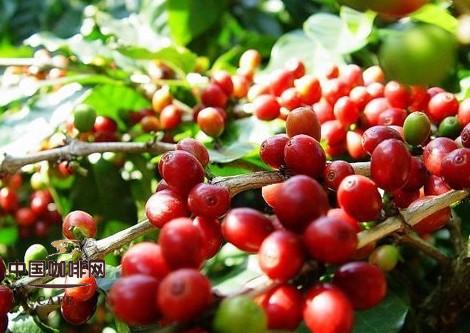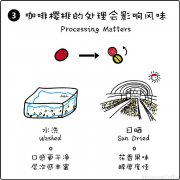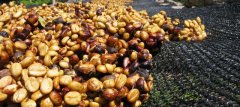Fine coffee treated with red wine
High-quality coffee beans are refined by water treatment. The coffee beans with less impurities can be obtained by the water washing method, but if the water quality and time are not properly controlled during the fermentation process, the coffee beans will easily be infected with the sour taste of excessive fermentation. and dry beans also need to pay attention to timely re-inspection to prevent coffee beans from being contaminated by wet ground and sundries. Processed beans should be dried in time, and the drying should also have a certain degree. Generally, the moisture content of processed beans is 11% 13%. Insufficient drying can easily make beans moldy, and excessive drying can easily affect the flavor of beans.
After SaSa won the WBC championship, the variety of Remy Sultan, as well as the red wine treatment it uses, has become a hot discussion in the industry.
In the process of coffee fruit to raw coffee bean treatment, there will be more or less "fermentation", whether it is washing treatment, honey treatment, or sun treatment will undergo this chemical change process. Different substances involved in fermentation (coffee peel, coffee pulp, coffee pectin, species of bacteria, distribution of bacteria), different fermentation environment (water and water, oxygen and oxygen, PH environment, etc.), different drying process (container material, natural sun, drying equipment, turning times, etc.), resulting in different post-treatment flavor and taste.
Lao Zhang (Jeremy Zhang, Zhang Yinzhe) coffee beans used in the WBC World Competition, and the creator series cooperated with 90 +, have a sealing "warm water blanching" step in the pre-treatment, which is also designed to control the degree of fermentation.
If the above factors related to fermentation can be controlled, the treatment process can be scientifically controlled according to the characteristics of coffee beans and their own needs. In his book long live Taiwan Coffee, teacher Han Huaizhong recorded some attempts and breakthroughs in the post-processing of Taiwan coffee in the past two years. I have asked Mr. Han about the advantages and disadvantages of the two methods of "changing varieties" and "doing later". (of course, if it is a good variety plus good treatment is the most ideal state.) compared with the two, post-processing is cheaper, less risky and more effective.
Let's go back to the subject of wine handling. SaSa selected Rume Sudan from Las Nubes, Columbia, referred to the fermentation process of wine treatment, put the coffee fruit in a sealed metal container for anaerobic fermentation, and purposefully controlled the PH value in the fermentation process, the type and number of bacteria involved in the fermentation and other factors to create the champion flavor in the cup. If this process of controlling fermentation is called "red wine treatment", then the winey treatment in Panama and Guatemala in the last two years should be called "red wine flavor treatment".
The origin of the "red wine treatment" comes from its treatment process, and the "red wine flavor treatment" is named from its treatment results-full alcohol thickness, red wine fermentation flavor, low acidity and excellent sweetness. (The result is a more full-bodied, slightly winey, sweeter coffee with less acidity.)
So what is the process of "red wine flavor treatment"? In fact, the treatment of Winey is strictly similar to that of solarization, or "efficient solarization". Pick the fully ripe coffee fruit and use industrial wind equipment to increase the air flow in the coffee bean drying space and accelerate the fruit drying.

Author: Fisher
Link: http://www.zhihu.com/question/28538203/answer/59123683
Source: Zhihu
The copyright belongs to the author. Commercial reprint please contact the author for authorization, non-commercial reprint please indicate the source.
Important Notice :
前街咖啡 FrontStreet Coffee has moved to new addredd:
FrontStreet Coffee Address: 315,Donghua East Road,GuangZhou
Tel:020 38364473
- Prev

Coffee bean treatment: honey treatment
Semi-washing (semi-lavado), also known as honey, miel, is actually a combination of tanning and water-washing fermentation to treat raw beans. First remove the peel and pulp of coffee, and then, according to the need, decide whether to use a pectin removal machine (desmucilaginador) to remove pectin, or how much pectin to remove, and finally dry the raw beans with shells by sun drying or machine drying or both.
- Next

What are the coffee beans treated with yellow honey?
Generally speaking, Costa Rica always prides itself on its exquisite water-washed coffee. It always picks ripe coffee fruits by hand and strictly controls the process of soaking and fermentation. the coffee produced under this process has an excellent balance of clean flavor and taste complexity; it has always been highly regarded in the industry. However, a new method of honey treatment has become a trend in recent years.
Related
- What is the meaning of lactic acid fermentation with coffee bean treatment?
- How to judge the state of foam by sound?
- How does the latte pull out the unicorn pattern? Come to get for a little trick to improve the flower pull!
- Will flower pulling affect the taste of the latte?
- Do you know the history of coffee?
- The difference between honey treatment and sun washing what is raisin honey treatment?
- What kind of milk can a novice use to make coffee foam to keep the foam longer? The correct method and skills of milking tutorial sharing
- Why do washed coffee beans taste sour? Flavor characteristics of washed Coffee
- Introduction to the skill of how to practice the size and height of water injection around the circle of hand-brewed coffee
- How do beginners practice coffee flower drawing from scratch?

